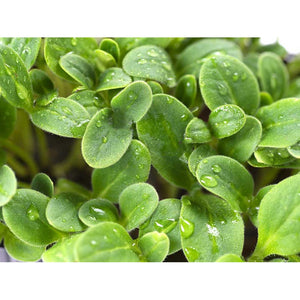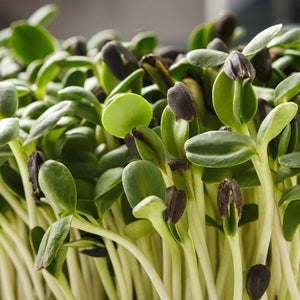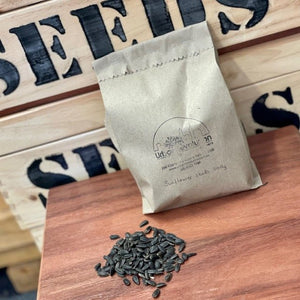Growing microgreens and sprouting are two of the easiest, fastest, and gratifying methods to grow food at home. They have grown in popularity due to their nutritional value, flavour, and texture enhancement to many dishes. You may need a green thumb and space to grow fruits and vegetables, but not for quick growing sprouts!
Sunflower Microgreen Seeds
- Easy to grow and delicious.
- The microgreens are a fabulous addition to smoothies, juices, sandwiches, salads, or as a topping for a range of dishes. A yummy, moreish snack simply on their own.
- They have a distinct nutty flavour, crunchy texture, thick leaves, and are long lasting in the fridge.
- 25 x 50 cm tray yields approx. 480-900 grams microgreens.
- Prefer a warm environment approx. 20-25degC.
- Nutritional content of these seeds is four-fold once sprouted.
- Very popular with chefs and nutritionists.
- 20 - 25% protein content.
- Contain Calcium, Iron, Zinc, and amino acids.
- They are rich in Vitamin B and E, and contain a range of vitamins including A, C, and D.
How to Grow Sunflower Microgreens:
Jar sprouted sunflowers sprouts are best grown from hulled (shelled) seeds and they do not produce long leafy sprouts, but small, short ones with underdeveloped first leaves.
These instructions are for sunflower seeds with a shell, and growing them in soil, which is the preferred method for sunflower microgreens. Seeds should not be roasted or toasted.
Sunflower microgreens can be prone to mould. To ensure success, do not overcrowd, wash your equipment after every batch, and replace the growing medium.
- Sow rate: 200g for a 20 x 50 cm growing tray.
Soaking and Sprouting
- Soak seeds for 8-12hrs. Place a bowl or lid on top of the floating seeds to keep them submerged.
- Sprouts seeds using the sprouting jar, hemp bag, or tray method. Sprouting softens the hard shell and improves germination.
- Rinse and drain twice daily till the roots emerge. After 12-24hrs, the tiny roots should be 5mm in length.
Planting
- Moisten soil or mat, flatten 2-3 cm soil in the tray. An option is to improve nutrient density by adding vermiculite, worm castings, or compost to the soil.
- Distribute sprouted seeds evenly over the tray without overlapping seeds.
- Press seeds into the soil or cover the seeds with a fine layer of soil to assist the Cotelydons (the first leaves) to remove the seed coating.
- Spray mist lightly and cover with a tray lid, spare tray, or hessian piece.
- Store in a ventilated room out of direct sunlight for 3-5 days until the seeds germinate.
- Lightly water 1-2 times daily, ensuring soil is not damp or soggy.
- When the top cover is slightly raised due to the sunflower shoots taking root, uncover and place in indirect light.
- Water twice daily. A seaweed solution can be added to your mister/sprayer.
Harvesting
- Seedlings are ready for harvest in 7-14 days.
- Harvest before the true leaves emerge when the plant is 8-10cm.
- Cut the stem 1-2cm above the seed.
- Eat the stems and first leaves.
Sunflower Seed Details:
- Botanical name: Helianthus annuus.
- Variety: Sunflower - Black Oil.
- Grown in Australia.
- Unhulled (contains their shell).
- Non-GMO.
- Open-pollinated.
- No chemical treatment.
Health Benefits of Microgreens and Sprouts
- Incredibly nutrient dense and low in calories. Studies have found that some microgreens contain up to 40 times higher levels of vital nutrients than their mature counterparts.
- Makes seeds easier to digest.
- Essential minerals and nutrients contained within the seeds/legumes become more bioavailable after sprouting (i.e. the nutrients become easier for your body to absorb and use).
- Delicious addition to a salad, sandwich, smoothie, or other meal. Add a crunch or a peppery zing depending on the type you choose (see a list of different microgreens/sprouts and their tastes here).
What's the Difference Between Microgreens and Sprouts?
Both microgreens and sprouts are the young shoots of germinated seeds - essentially baby plants. You can grow grains, legumes, nuts, and seeds as sprouts or microgreens and people are now realising the benefits of eating these young plants.
Sprouts
Sprouts are not grown in soil or other growing mediums, but rather are germinated with only water, usually in a jar, hemp bag, or on a paper towel. They do not need light but require rinsing/misting at least twice per day, are ready to eat in 3-5 days and both the seed and plant are consumed.
Microgreens
Microgreens are grown in soil, a hydroponic growing pad, or in another growing medium such as cocopeat or hemp. They require light, are usually ready to eat in 5-15 days depending on what you're growing, and are generally cut off above the soil so only the stems and first leaves (the Cotelydons) are consumed.
For further information see our article - 5 Ways To Grow Microgreens and Sprouts
How to Store Microgreen and Sprouting Seeds
Store seeds in a cool, dry place (under 10°C) or in an airtight container in the fridge. Do not expose to moisture or direct sunlight. Grains, cereals, and pulses should be refrigerated.
Some of our Microgreen Seeds
- Snow Pea Oregon Sugar Pod
- Coriander Microgreens
- Beetroot Microgreens
- Basil Microgreens
- Australian Black Sunflower Microgreens
- Broccoli Microgreens
- Green Cabbage Microgreens
- Kale Microgreens
- Mung Microgreens
- Mustard Microgreens
- Radish Daikon Microgreens
Where to Put all your Seeds! - Timber Seeds Box
*** Due to quarantine restrictions we are unable to send seeds to Tasmania or South Australia***







